Population Distribution and Land in the Netherlands
The population is not distributed equally throughout the country. The distribution pattern is dominated by two main features:
(a) 65 per cent of the population live in towns with more than 10,000 inhabitants.
(b) 47 per cent live in the provinces of Utrecht and North and South Holland.
The population in the towns is growing at a far greater rate than that in the rural areas. In general, however, the excess of births over deaths is greater in rural areas than in the towns.
This clearly shows that the ever-growing urbanization of the Netherlands is a consequence of migration from country to town. This depopulation of the countryside is caused in no small measure by the mechanization of agriculture, which has reduced the need for manpower.
Furthermore, the towns exert a strong attraction, offering as it does a greater range of employment in industry with its better working-hours, and a larger choice of schools and vocational training courses. In the past few years, however, the large cities appear to have stopped growing.
Many firms are setting up in small towns or in rural districts, which, thanks to a good system of public transport and an excellent road network, are within easy reach of the large towns.
Urbanization has occurred most especially in those places offering the most favourable conditions for the establishment of industry, notably to the south-west of a line between Alkmaar and Arnhem. Large population concentrations occur therefore in the west of the
Netherlands (the West Holland Conurbation), North Brabant (the chain of towns including Breda, Tilburg and Eindhoven) and South Limburg. In the east of the Netherlands, Twente (Enschede and Hengelo) constitutes a fast-growing population centre. The most important concentrations of population arose in the first place in the west of the country, where the great international seaports exercised a strong attraction on industry and commerce.
In North Brabant the wool and electrical industries caused the towns to grow, while in Twente the cotton and engineering industries were the causative factor. South Limburg has developed as a modern industrial area on the strength of its coal-mining industry.
Historical Background:
Netherlands is considered the oldest United Kingdom under the Duchy of Europe, at the same time notes for her high birth rates.
Despite, their unique Geographical position at the mouth of River Rhine and near the North sea as the Gateway to Europe. It suffered serious problems of flooding and pollution (salination presented by the sea). This caused death to life and, destroyed property and made a continuous threat to both.
On the 1st February 1953, the sea managed to break through and flooded 375,000 acres, destroying 47,000 homes and killed 1800 people.
Hence with great desire to create secure permanent settlement and more land to practice farming, they devised means enforcing the sea back and reclaiming old as well as new land by building strong walls known as dykes.
The Dutch are known for the long - term hard work and political stability and this has enabled them to achieve what they have so far achieved and will continue to achieve. Their marine engineering industry is one of the highly developed in the world.
Land Reclamation
The Dutch have a saying: "God made the sea, but man made the land." The saying is not without an element of truth for much of present-day Netherlands is land won from the sea. The word reclamation means "to convert in order to obtain ".
The country, indeed, provides a remarkable example of man's conquest of his environment. For something like two thousand years the peoples inhabiting the area have waged a grim struggle against the rivers and the sea. "For the Dutch the sea has ever been both friend and foe.
Friend because sea and rivers are vital to the country's prosperity: For because generations of farmers and dyke-builders-have waged an endless battle against the water. Their history is epitomized in the motto of the province of I struggle and emerge.
The Dutch struggle with the water has been one of constant thrust and parry with man gradually gaining the upper hand. Time and again, however, the sea in angry mood has struck back and the country's history is punctuated with disastrous floods which, temporarily. have reversed man's gains.
Netherlands: Areas below Sea level
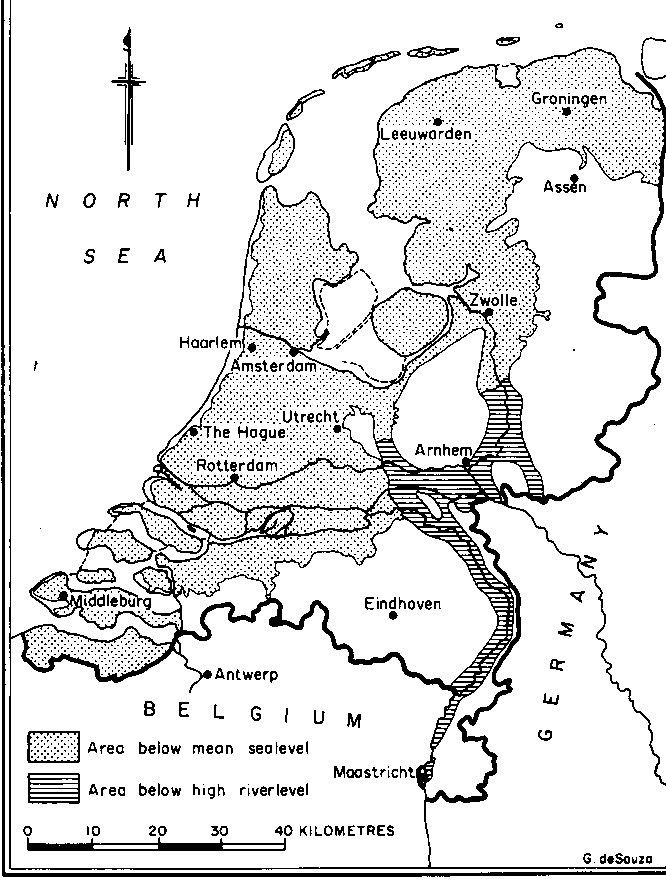
There are three types of land reclamation schemes. These include:
- Reclamation of land from the sea to create a marine polder.
- Reclamation of land from Rivers to form a riverine polder.
- Reclamation of Geestlands - ie sand Dunes heath , infertile areas.
- Reclamation of land from swampy and Marshy or Muddy areas.
How a Polder is made.
A Polder is a Dutch word which denotes a low-lying area which is enclosed by a strong wall called dyke and has been artificially drained and converted into land ideally suitable for farming and animal husbandry.
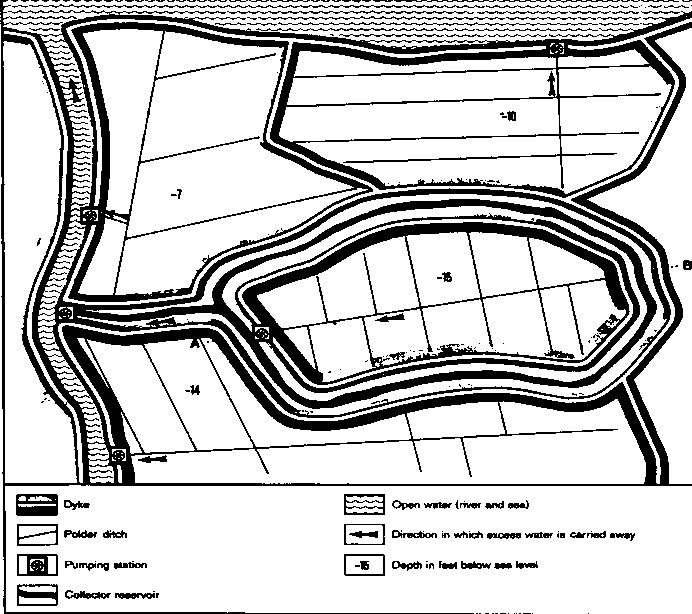
Stages in the formation of polder
A sea - bed to be reclaimed is first sealed off (cut off) by the construction of a circular wall known as a Ring Dyke.
The foundation of the dyke is made by huge quantities of clay, sand, mud and stones.
The sides of the wall from outside are protected by Bitumen from open erosion of sea currents and tides by using polythene or bitumen or both to cover the dykes.
The top of the dykes is carefully made of concrete.
The pumping stations are put on the top of the dyke. Formerly the pumping was done by wind - mills known as Kinder Dyke wind mills, but now modern Diesel Engines or Electric Equipment are in use today.
The Marshy land enclosed inside the Dyke is partitioned into rectangular Blocks by drainage ditches or channels. Water is drained into these ditches. All the excess water is pumped up from the Polder and discharged into the Ring canal.
These canals are constructed to drain the water towards the pumping station and finally to Rivers.
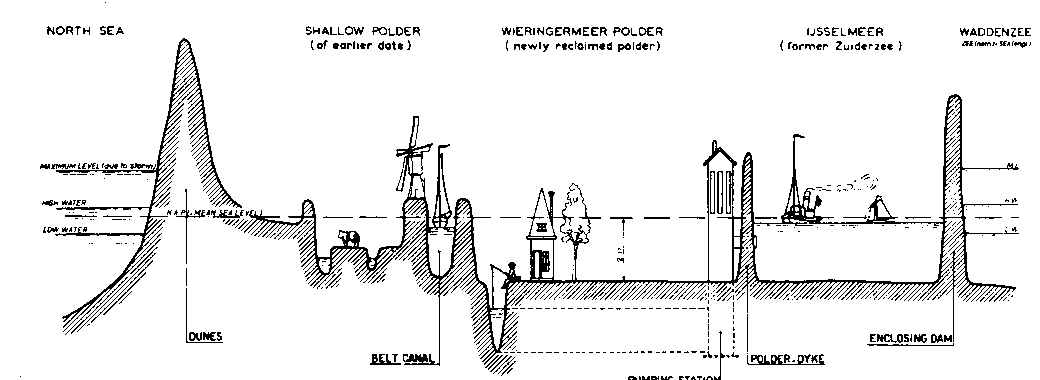
Diagrams showing the creation of dykes
Further work is done once the land has been reclaimed. The land is put to suitable farming, roads, railways, on top of Dyke, berges, on canals and villages and towns are built according to the plan.
Characteristics of initial farming on the Polderland.
A marine polder contains salt when it has just been pumped dry,
This salt is got rid of by leaving polder to rest for 4 years, meanwhile special plants are grown to remove excess salts and mixing gypsum to the ground which reacts with the salts £2 order to produce a soluble compound that is washed by fresh water in the reservoirs or rainfall.
The underground water level is carefully controlled by pumping. Very careful ploughing starts with the mixing of sands and marine clays and fertilizers onto the sols.
After a period of 4 years, the first two crops are introduced into the soil, these are rye and Kale (type of cabbage) and rotated usually with sugar beet and Irish potatoes.
NB: This process is from 1 - 4 years after which the polder is used for growing various crops as the farmer may desire.
The Reclamation of the Zuider Zee Project
The most spectacular of all Dutch reclamation projects is, of course, the Zuider Zee project. This great scheme has captured the imagination of the world.
Two points in connection with the Zuider Zee are worth emphasising: the first is that the sea only came into existence a few centuries ago as a result of the breaching of the Frisian sand-bar; and secondly that the idea of reclaiming it back again is nearly three centuries old. The suggestion was first put forward as long ago as 1667 by Hendrik Stevin and although a number of tentative plans were put forward from time to time it was not until the end of the nineteenth century that a reclamation
This is the largest project that has ever been achieved by the Dutch. The scheme involved gradual reclamation of the Zuider Zee (sea) for agricultural and settlement purposes.
The scheme started in 1927 with the building of a massive barrier (Dam) of 30 km long, 300 metres wide and 8 metres above normal sea level. This Dam was completed in 1932 and reduced the coastline for 320 km from the main land. It was built across the mouth of the Zuider Zee from Weiringermeer to Friesland, excluding the sea. The area inside was then divided into folders namely:
1. The North East polder (48,000 Hectares, 1937 -1942).
2. The East Flevoland polder (54,000 Hectares, 1950-1957)
3. The Southern Flevoland polder (44,000 Hectares , 1959-1967)
4. The Markerwaard polder (60,000 Hectares , 1979 -1983)
The North - West (Wieringermeer) polder (14,000 Hectares 1927 - 1930). This was the first scheme to be embarked on, Hence the total area in this project which has been reclaimed is of 220, 000 hectares comprising of 10% of more arable land added to the already existing plan was drawn up upon which positive action was to be taken.
Work on the Zuider Zee reclamation scheme commenced in 1923. It is interesting to note that the plan which was finally adopted was, in all its essentials, that put forward by Leiy. It advocated
- the building of an enclosing dyke from Noord Holland to the Isle of Wieringen and thence across the mouth of the Zuider Zee to Friesland; this would seal off the Zuider Zee from the Waddenzee and, in effect, convert it into a great lake;
- four large areas, one outside the bottle-neck and the remaining three in the body of the Zuider Zee, were to be dyked and drained; the total area of reclaimed land was to amount to half a million acres; and
- the remnant of the Zuider Zee that was left was to become a freshwater lake which would serve as a reservoir and would maintain the water- table in the empoldered land; this lake IJsselmeer, was to be 250,000 acres in extent. This ingenious but relatively simple and practical plan was adopted,
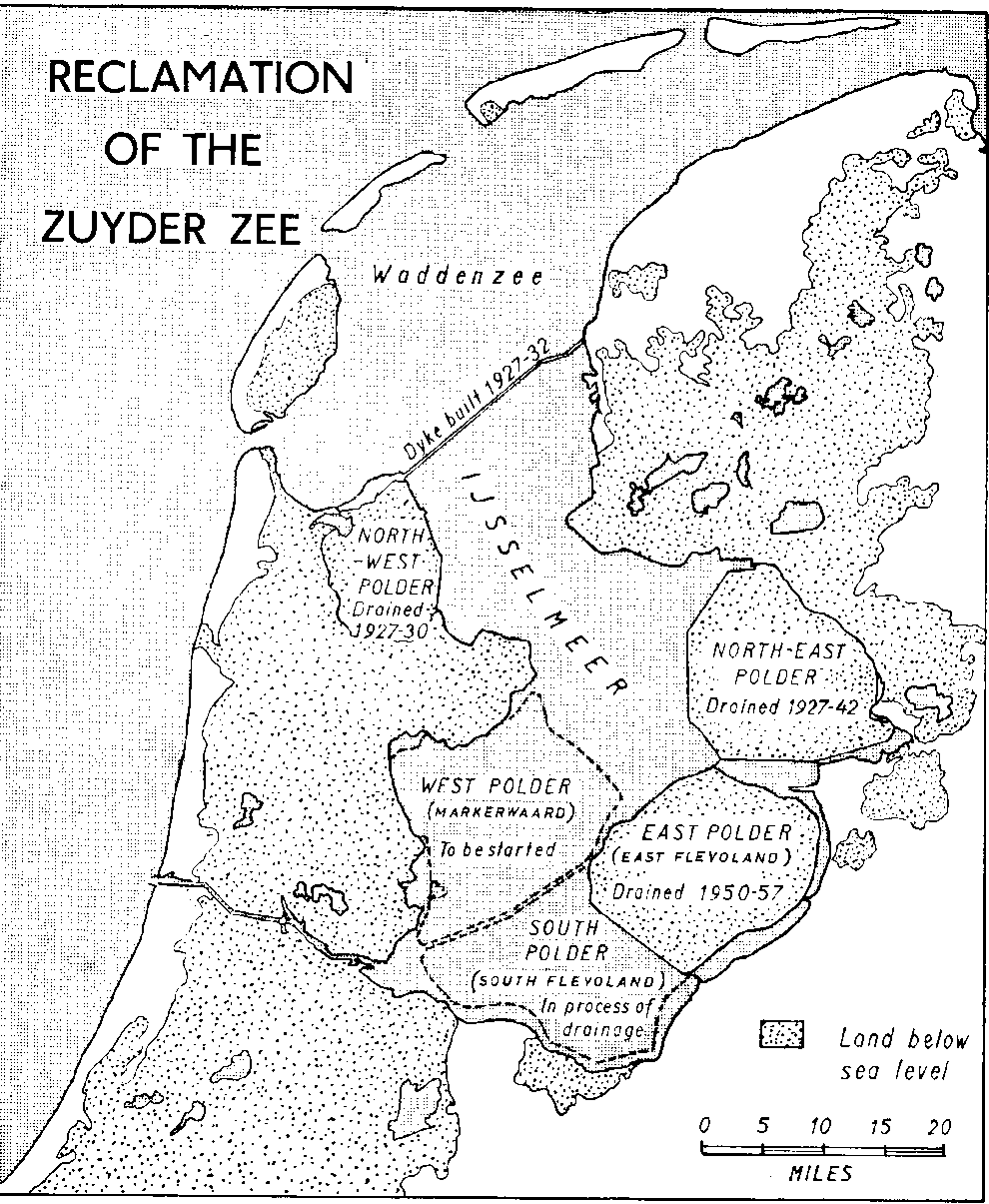
The dyke between Noord Holland and the Island of Wieringen was completed in 1924, By 1927 the great enclosing dyke between Wieringen and Friesland was begun. An enormous causeway nearly twenty miles long and wide enough to carry a first-class road and a motor-cycle track was built from Den Oever, in Noord Holland, to Zurig, in Friesland. After five years' labour the last gap in the great dyke was closed. Thus at precisely 1 p.m. on the 28 May 1932 the Zuider Zee ceased to be a sea and became a lake. The first major victory in the long struggle had begun.
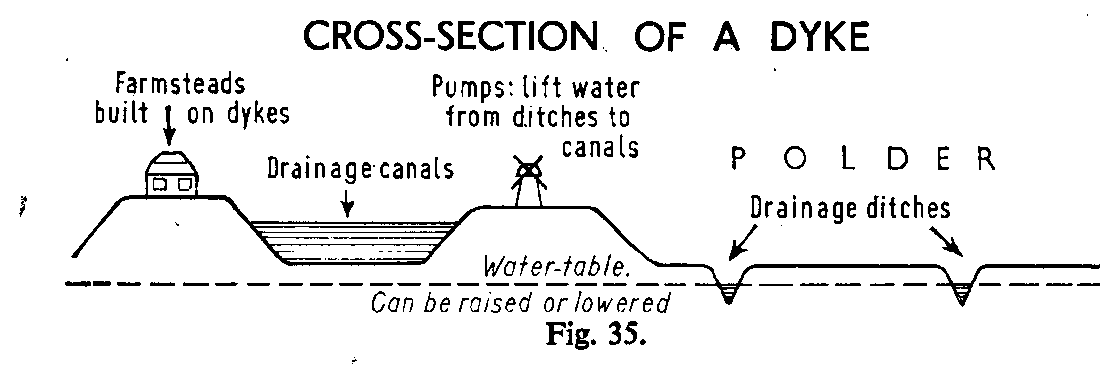
Benefits of the Zuider Zee
Land created for farming: Approximately: 220,000 hectares of land have been reclaimed, the polder land is now very fertile and used for both arable and Dairy farming. 85% of the land in East Flevoland is used for arable farming.
The total land is divided into small farms. Intensive cultivation methods are practiced for example crop rotation, fertilizers, spraying plus Grass thatched light and temperature maintenance are applied to speed up crop growth as well as use of selected seeds. Crops include, rye, oats, barley, wheat, potatoes, sugar beet, integrated with vegetables and fruits in some parts.
In other parts, the Markerwaard, the south Flevoland polder, rich pastures are made suitable for Dairy farming especially the rearing of the Friesian cattle, which give high yields of milk.
Fresh water: Behind the massive barrier wall, a fresh water lake known as lake Yssel (Ijssel) and another one , the Wieringermeer lake were created. Both of them are no longer subject to tidal influence of the North Sea. They are now able to supply fresh water for both human and livestock consumption. The water on Lake Yssel acts as a reservoir for irrigation on periods of prolonged droughts.
Fish: There is sufficient herrings, cods which are contained artificially created lake (L. Yssel)
Prevention of salination: The surrounding areas around former Zuider Zee (sea) no longer suffer from salination (bring contaminated by salt from the sea) as they are now being provided with better drainage system by canals.
Transport: The locks on the Dam allow ships to enter and leave the lake bringing in farm inputs and taking out both agricultural and dairy products.
A high way has been constructed on top of the massive barrier dam. This has helped in reducing the distance between North Holland and Friesian by 320 km and creating a short cut from Amsterdam to North Germany.
Tourist attractions: This project has attracted a lot of various visitors and creating much foreign exchange for the Dutch.
Other Reclamation Projects
Although the Zuider Zee project makes a ready appeal to the imagination, it should be remembered that many other smaller reclamation schemes have been, and are being, carried on elsewhere in Holland. For example, in Zeeland and around the coasts of Groningen and Friesland natural accretion of land is going on through marine deposition and, when a certain stage is reached, the mudflats are dyked to stop inundation by the sea and the process of reclamation is then begun.
It is estimated that since the thirteenth century, when records first began to be kept, 160,000 acres of land around the coasts and in inlets have been reclaimed in this way.
Another notable scheme is that in north Friesland where the Lauwerszee to the west of Zoutkamp is being reclaimed; the technique employed here is to construct settling basins so that the accumulation of marine silt, brought by the daily tides, is speeded up. Eventually some 13,000 acres will be reclaimed.
THE DELTA PLAN
This is situated in the southwest of Netherlands, comprising of Islands and broad, deep inlets (estuaries) which reach far inland- Rivers;-Rhine, Maas, Scheldt have their mouth on this lower basin before they join the sea.
Flooding has been creating a constant threat during high tide periods and during the high volume of rivers.
The Delta plan came into force after the worst disaster of 1953 when the sea entered angrily and salinated plenty of land, leading to heavy loss of human life, livestock and property.
The Dutch have now embarked upon another bold plan, the so called Delta Plan, which is in the process of completion. This has involved the closing of portions of the Zeeland and Zuid Holland inlets by the construction of three principal coastal dykes which, with the help of secondary dykes, has excluded the sea and turned the former tidal inlets into large freshwater lakes. Note that the waterway leading to Rotterdam and the West Scheldt estuary will not be affected. The Delta Plan has four main aims:
- to create a defensive bastion against threat of flooding by the sea;
- to improve navigation in an area which is at present tidal and is made treacherous by frequently shifting sandbanks;
- to provide a supply of fresh water, for Holland, strange as it may seem, suffers from inadequate fresh water supplies; and
- to link the relatively isolated delta islands together by a road system. The initial step in the implementation of this Delta Plan was taken when the Brielse Maas, a sea inlet near Rotterdam, was dammed and a large freshwater lake created.
Following the Diagram below of the Delta plan for Reclamation of South West Netherlands. All Estuaries of the Delta were closed except the Western Scheldt which access to Antwerp port.
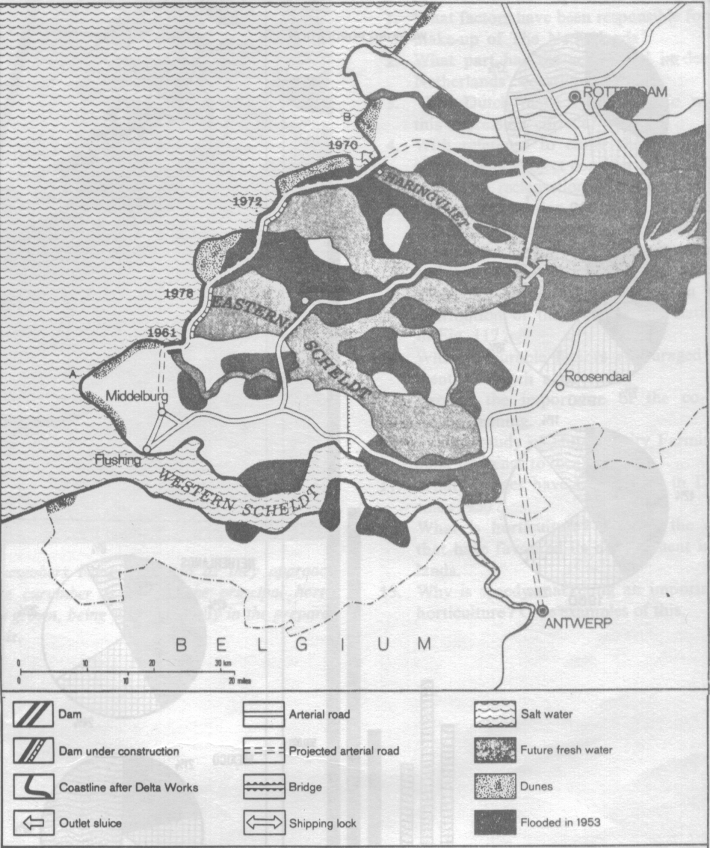
SOLUTION:
The Delta plan was the scheme which was designed to keep the sea out by building four Dams of 100 km long across the mouth of four estuaries leaving behind only two inlets open; the Rotterdam waterway and the Western Scheldt, which lead to Rotterdam international sea port and Antwerp port.
The work of the Delta plan began in 1960s and was completed in 1980 and costing worth 2 million pounds (£2m). The first dams were aimed at removing salt of dykes formed behind the estuaries.
Benefits of the Delta plan
More land for farming created: The Delta plan created more land for both Agriculture and settlement. Horticulture the growing of fruits, flowers and vegetables (onions, cabbages, carrots etc) is important, potatoes. Rye, sugar beet are grown on an intensive scale by constant use of humus and fertilizers.
Fresh water: Now the South West is free from the invasion of the sea after the construction of the defence wall. The water formed behind the dams is fresh and is used for irrigating crops during droughts and for both animal and human consumption, and desalinating the land (and preventing salty sea water from polluting the inland River waters.
Fish: Fish is reared in lakes created behind Dams to alleviate protein deficiencies among the Dutch people.
Transport: Good roads have been built on top of Dams linking the islands in the area with the mainland. The Roads on the Dams have shortened the Dutch coastline by 700 km.
Tourist attraction: The level of creativity and serious work is now attracting numerous visitors on either study tour or recreation purposes on the sandy beaches at the coast and in the Fresh water lakes.
Industrial development: Its close proximity to the sea has given it chance to attract heavy industrious specially petro- chemical industries, metallurgical , glass ware works and oil refining industries.
The Effects of Polderisation
The reclamation of land from water has had several very important effects and these we must note.
When the surface of a polder has been drained of its superficial water, ditches must be dug in the waterlogged ground to drain the earth of its moisture. This drainage is done on a rectilinear system with the result that the plots of land are rectangular in shape and necessarily small. There is thus an orderly arrangement of land.
The farmers have control of the water-table and this can be raised or lowered according to needs. If for example, the land is under grass for dairying purposes the water-table can be raised to within a few inches of the surface; conversely, for arable crops it can be lowered. In this way the farmer is relieved of complete dependence upon the rainfall.
Because of the high cost of empoldered land, which may be anything between £300 and £500 per acre, rents are accordingly also high from, roughly £7-50 to £12 per acre. And since the holdings are expensive and small, agriculture to be profitable must be intensive in its character; hence the importance of market-gardening and intensive dairying in the polder lands.
So far we have been concerned with the struggles of the Dutch with the water but we should not neglect their efforts at reclamation of the interior Heathlands and moorlands.
In Groningen and Drenthe large areas consist of sandy, infertile soils, for example the Bourtanger Moor in the north-east, whilst in southern Holland the Veluwe to the south-west of Lake Ijssel, which is really an extension of the Belgian Kempenland, is a similar infertile area. Such wastelands are being steadily reclaimed and the sterile sands being converted into productive soils. This is done by levelling the land, dressing with peat, spreading mud from the canal beds, and applying town refuse. The land is then ploughed and the whole thoroughly mixed.
Lime and chemical fertilisers and animal manure, when available, are then applied. Processing and improvement on these lines have redeemed thousands of acres of formerly virtually useless land.
One of the largest of these reclamation schemes has recently taken place in Drenthe where some 200,000 acres of peat moor have been converted for arable cultivation.
The Geestlands (Heathlands) Reclamation Scheme.
The Geestlands constitute the higher parts of the country (50 m - 120 m, found in three areas: -
1. The central Geestlands known as the volume situated South of the Zuider Zee polders.
2. The Eastern Geestlands along the German Boarder.
3. The Southern coastlands, South of River Meuse.
The major problem was that these areas consist mainly of sandy soils often covered with peat and peat mosses unsuitable for arable farming. In some areas there is bare sand and in others real sand dunes (mills).
Solution:
The Dutch used combined efforts to improve the Geestlands into ideal arable land.
First of all they converted the peat - bogs into good land by digging canals across the Geest in order to drain the Bogs. The peat itself embedded is highly practiced in scale foe pork, almost 4 metres deep is removed to surface and turned into fuel. The sandy soils are gradually reclaimed by adding manure and fertilizers.
Benefits